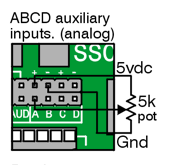Hello!
I’ve got a question that is probably very easy to answer, but I haven’t been able to find how others have done it so who knows. I am building a custom quad and picked up 4 foot force sensors. I then realized the SSC32 doesn’t have enough input pins for that many! 
 I also was hoping to use a bluesmirf to replace my serial cable. All of my computation is currently done on my computer and I am just printing strings (using matlab) to the SSC32. I was hoping to be able to query the SSC32 for the voltage signals off the analog inputs. How would I accomplish this task of hooking up 4+ inputs? do I need to use an additional/different board?
I also was hoping to use a bluesmirf to replace my serial cable. All of my computation is currently done on my computer and I am just printing strings (using matlab) to the SSC32. I was hoping to be able to query the SSC32 for the voltage signals off the analog inputs. How would I accomplish this task of hooking up 4+ inputs? do I need to use an additional/different board?
Thanks!!
The SSC-32 has four analog inputs located in position 10 on the board:
lynxmotion.com/images/html/b … tm#readain
You can easily connect a Bluesmirf, though the easiest physical connections would be to use the following:
robotshop.com/productinfo.as … lang=en-US
robotshop.com/productinfo.as … lang=en-US
robotshop.com/productinfo.as … lang=en-US
If its that simple then explain to me this:
the SSC32 has 4 sets of 2 pins (A, B, C, & D). However, each analog input requires 3 pins as shown in your users guide to that board…
Additionally the diagram for setting up the bluesmirf with the SSC32 shows the use of an additional 2 of these pins.
So, how do I set these devises up?
Thanks

Ideally the design of the board would provide three pins for the analog inputs: signal, V and GND. You can take GND and V from any of the servo pins and only connect the signal pin if you’d like. Same goes for the BlueSmirf. The BlueSmirf’s GND can be connected next to the Tx / Rx pins on the SSC-32 (you’ll notice a GND there). We do understand the frustration and will be correcting this with the SSC-32U.
The +v output of the A pin can be split to supply a large number of other chips and such. The - of the B pin can be split to supply ground to a large number of other chips and such. I’ve made + and - headers out of dip sockets by soldering a bare wire to the pins on each side of the socket so one side would have + sockets and the other would have - sockets for wires. You can get analog multiplexing chips like below so you can have many inputs to a single analog input pin (but only one at a time).


